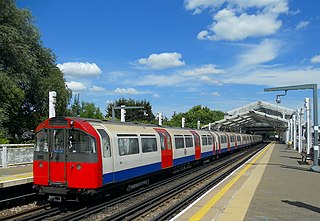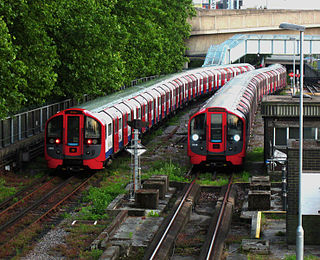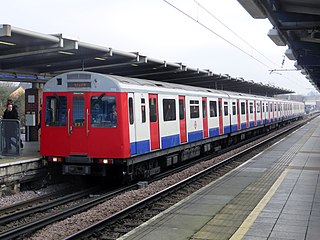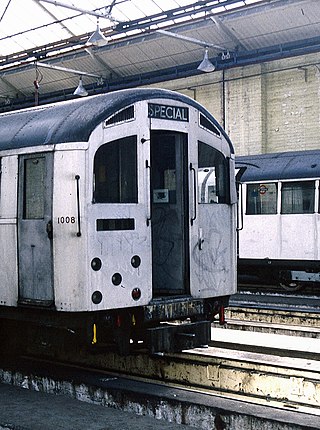
The Metropolitan line, colloquially known as the Met, is a London Underground line between Aldgate in the City of London and Amersham and Chesham in Buckinghamshire, with branches to Watford in Hertfordshire and Uxbridge in Hillingdon. Printed in magenta on the tube map, the line is 41.4 miles (66.7 km) in length and serves 34 stations. Between Aldgate and Finchley Road, the track is mostly in shallow "cut and cover" tunnels, apart from short sections at Barbican and Farringdon stations. The rest of the line is above ground, with a loading gauge of a similar size to those on main lines. Just under 94 million passenger journeys were made on the line in 2019.

The Bakerloo line is a London Underground line that runs from Harrow & Wealdstone in suburban north-west London to Elephant & Castle in south London, via the West End. Printed in brown on the Tube map, it serves 25 stations, 15 of which are underground, over 23.2 kilometres (14.4 mi). It runs partly on the surface and partly through deep-level tube tunnels.

The Jubilee line is a London Underground line that runs between Stanmore in suburban north-west London and Stratford in east London, via the Docklands, South Bank and West End. Opened in 1979, it is the newest line on the Underground network, although some sections of track date back to 1932 and some stations to 1879.

The North London line (NLL) is a railway line which passes through the inner suburbs of west, north-west, north, and north-east London, England between Richmond in the south-west and Stratford in the east, avoiding central London. Its route is a rough semicircle.

The Jubilee Line Extension (JLE) is the extension of the London Underground Jubilee line from Green Park to Stratford through south and east London. An eastward extension of the line was first proposed in the 1970s. As part of the development of London Docklands, the line was extended to serve Canary Wharf and other areas of south and east London. Construction began in 1993, and it opened in stages from May to December 1999, at a cost of £3.5 billion.

The London Underground 1973 Stock is a type of rolling stock used on the Piccadilly line of the London Underground. It was introduced into service in 1975 with the extension of the line to Hatton Cross, followed by a further extension to Heathrow Central in 1977. A total of 86 six-car trains were built.

The 1959 Tube Stock was a type of London Underground tube train constructed in the late 1950s. They were intended for use on the Piccadilly line, but also saw use on several other tube lines. It was the first production tube stock to have unpainted aluminium alloy bodywork.

London Underground rolling stock includes the electric multiple-unit trains used on the London Underground. These come in two sizes, smaller deep-level tube trains and larger sub-surface trains of a similar size to those on British main lines, both running on standard gauge tracks. New trains are designed for the maximum number of standing passengers and for speed of access to the cars.

The Standard Stock title was applied to a variety of Tube stock built between 1923 and 1934, all of which shared the same basic characteristics, but with some detailed differences. This design is sometimes referred to as 1923 Tube Stock, 1923 Stock, or Pre 1938 Stock. Most of the Standard Stock was built to replace the first generation of "Gate Stock" Tube trains or to provide additional trains for extensions built in the 1920s and early 1930s. Standard Stock cars consisted of motor cars, with a driver's cab, behind which was a "switch compartment" occupying approximately one-third of the length of the car, plus trailer cars and "control trailers", with a driving cab but no motor. All were equipped with air operated sliding doors. The guard's door on the earlier trains was a manually operated, inward-opening hinged door.

The London Underground O and P Stock electric multiple units were used on the London Underground from 1937 to 1981. O Stock trains were built for the Hammersmith & City line, using metadyne control equipment with regenerative braking, but the trains were made up entirely of motor cars and this caused technical problems with the traction supply so trailer cars were added. P Stock cars were built to run together with the O Stock cars now surplus on Metropolitan line Uxbridge services. The trains had air-operated sliding doors under control of the guard; the O Stock with controls in the cab whereas the P Stock controls in the trailing end of the motor cars. The P Stock was introduced with first class accommodation, but this was withdrawn in 1940.

The London Underground 1962 Stock was a type of London Underground tube train built for use on the Central line. They were used on the Central line between 1962 and 1995, with some later being transferred to the Northern line where they were used until 1999.

The London Underground D78 Stock, commonly referred to as D Stock, was a type of sub-surface rolling stock which operated on the District line of the London Underground, except on the Wimbledon to Edgware Road service. The first units were withdrawn in January 2015 with the last withdrawn on 21 April 2017.

The London Underground 1972 Stock is a type of rolling stock used on the London Underground. The 1972 Stock was originally ordered to make up the shortfall in trains on the Northern line's 1959 Tube Stock fleet, but is currently used on the Bakerloo line. Following the withdrawal of the British Rail Class 483 EMUs in 2021, the 1972 Stock are now the oldest EMUs in passenger service in the United Kingdom. A total of 63 seven-car trains were built in two separate batches.

The Kawasaki Heavy Industries C151 is the first generation electric multiple unit (EMU) rolling stock in operation on the North–South and East–West lines of Singapore's Mass Rapid Transit (MRT) system, manufactured by a consortium led by Kawasaki Heavy Industries (KHI) under Contract 151. They were first introduced in 1987 and are the oldest trains in operation on the network.

The London Underground 1986 Tube Stock consisted of three prototype electric multiple units built for the London Underground in 1986/87 that led to the development of the 1992 Stock.

The London Underground 1996 Stock is a type of rolling stock used on the Jubilee line of the London Underground. The trains were built by GEC Alsthom-Metro-Cammell and entered service in 1997. They are similar to the 1995 Stock used on the Northern line.

The London Underground 1995 Stock is a type of rolling stock used on the Northern line of the London Underground. A total of 106 six-car trains were built, entering service between June 1998 and April 2001, replacing the 1959 Stock, 1962 Stock and 1972 Stock. They are very similar to the 1996 Stock used on the Jubilee line.

The London Underground 1956 Stock consisted of three prototype units built before mass production of the 1959 tube stock. These units were tested on the Piccadilly line and remained in service after production trains were introduced. Later they were transferred to the Northern line, but in 1995 they were replaced as non-standard by 1962 Stock cascaded from the Central line.

The Metro Cammell EMU is the oldest variation of electric multiple unit that operates on the MTR rapid transit railway system in Hong Kong. A total of 768 cars were built by Metro-Cammell in England between 1977 and 1994, and refurbished from 1998 to 2001 by United Goninan.

The London Underground opened in 1863 with gas-lit wooden carriages hauled by steam locomotives. The Metropolitan and District railways both used carriages exclusively until they electrified in the early 20th century. The District railway replaced all its carriages for electric multiple units, whereas the Metropolitan still used carriages on the outer suburban routes where an electric locomotive at the Baker Street end was exchanged for a steam locomotive en route.




















